
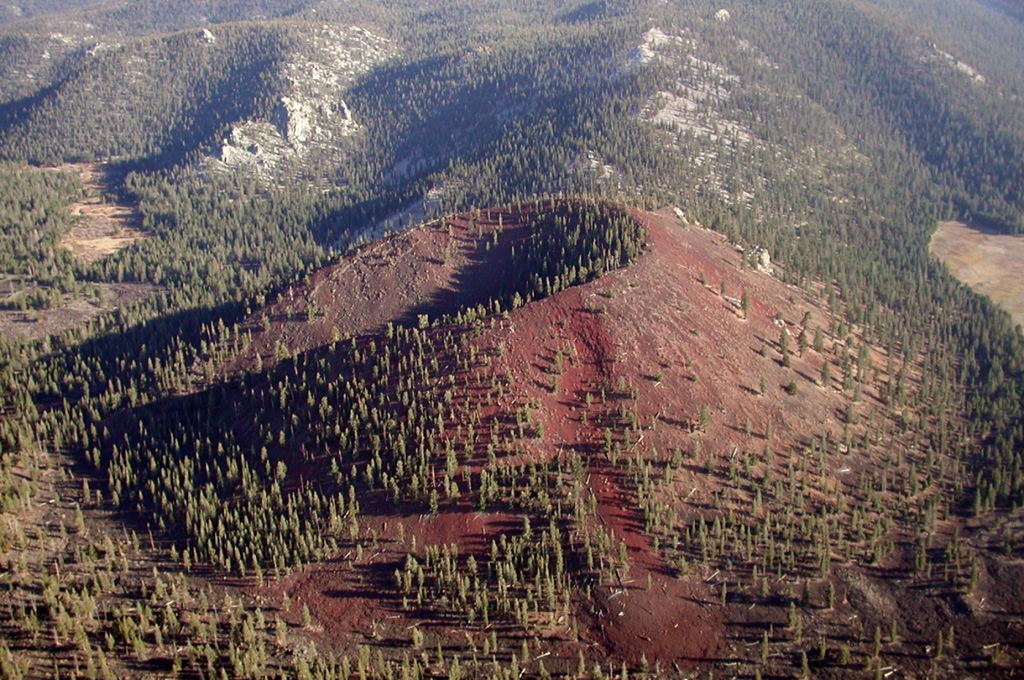
The Global Volcanism Program has no activity reports available for Golden Trout Creek.
The Global Volcanism Program has no Weekly Reports available for Golden Trout Creek.
The Global Volcanism Program has no Bulletin Reports available for Golden Trout Creek.
|
|
||||||||||||||||||||||||||
There is data available for 1 confirmed eruptive period.
55500 BCE ± 3500 years Confirmed Eruption (Explosive / Effusive)
| Episode 1 | Eruption (Explosive / Effusive) | Groundhog Crater | ||||||||||||||||||||||||||||
|---|---|---|---|---|---|---|---|---|---|---|---|---|---|---|---|---|---|---|---|---|---|---|---|---|---|---|---|---|---|
| 55500 BCE ± 3500 years - Unknown | Evidence from Isotopic: Cosmic Ray Exposure | ||||||||||||||||||||||||||||
|
List of 4 Events for Episode 1 at Groundhog Crater
|
|||||||||||||||||||||||||||||
This compilation of synonyms and subsidiary features may not be comprehensive. Features are organized into four major categories: Cones, Craters, Domes, and Thermal Features. Synonyms of features appear indented below the primary name. In some cases additional feature type, elevation, or location details are provided.
Synonyms |
||||
| Toowa Valley | Golden Trout Volcanic Field | ||||
Cones |
||||
| Feature Name | Feature Type | Elevation | Latitude | Longitude |
| Groundhog | Pyroclastic cone | 2854 m | 36° 21' 33.00" N | 118° 19' 1.00" W |
| Little Whitney | Pyroclastic cone | 2682 m | 36° 23' 6.00" N | 118° 20' 9.00" W |
| South Fork
Red Hill |
Pyroclastic cone | 2881 m | 36° 21' 23.00" N | 118° 17' 3.00" W |
| Tunnel Cone | Pyroclastic cone | 2839 m | 36° 21' 59.00" N | 1118° 16' 56.00" W |
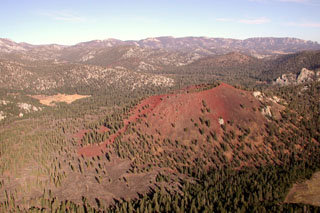 Reddish oxidized scoria mantles the slopes of Groundhog cinder cone, the youngest of Golden Trout Creek volcanic field. The cone is seen here from the west, with Tunnel cone (left center) and South Fork cone (beyond the right-hand rim of Groundhog) behind it. The light-colored area at the left center is Groundhog Meadow. Basaltic lava flows from Groundhog cone visible at the lower left extended 6 km down Golden Trout Creek.
Reddish oxidized scoria mantles the slopes of Groundhog cinder cone, the youngest of Golden Trout Creek volcanic field. The cone is seen here from the west, with Tunnel cone (left center) and South Fork cone (beyond the right-hand rim of Groundhog) behind it. The light-colored area at the left center is Groundhog Meadow. Basaltic lava flows from Groundhog cone visible at the lower left extended 6 km down Golden Trout Creek. Groundhog cinder cone, the youngest of the Golden Trout Creek volcanic field, is breached to the NE. Groundhog cone was the source of a Holocene lava flow that traveled 6 km to the west down Golden Trout Creek The volcanic field consists of a group of Quaternary alkali olivine basaltic cinder cones and lava flows in the Sierra Nevada about 25 km south of Mount Whitney. Lava flows erupted through light-colored Mesozoic granitic rocks of the Sierra Nevada batholith visible behind Groundhog cone and on its upper right side.
Groundhog cinder cone, the youngest of the Golden Trout Creek volcanic field, is breached to the NE. Groundhog cone was the source of a Holocene lava flow that traveled 6 km to the west down Golden Trout Creek The volcanic field consists of a group of Quaternary alkali olivine basaltic cinder cones and lava flows in the Sierra Nevada about 25 km south of Mount Whitney. Lava flows erupted through light-colored Mesozoic granitic rocks of the Sierra Nevada batholith visible behind Groundhog cone and on its upper right side.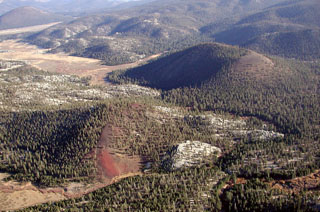 Tunnel cinder cone (lower left) and South Fork cone (upper right) are seen from the NW with Ramshaw Meadow at the upper left. The South Fork cone was erupted about 176,000 years ago and produced the largest lava flow of the volcanic field, which traveled 10 km to the west, possibly as far as the floor of Kern Canyon. Tunnel cone to the north of South Fork (Red Hill) cone is undated, but its lava flow is overlain by glacial deposits and it is thought to be only slightly younger than South Fork cone.
Tunnel cinder cone (lower left) and South Fork cone (upper right) are seen from the NW with Ramshaw Meadow at the upper left. The South Fork cone was erupted about 176,000 years ago and produced the largest lava flow of the volcanic field, which traveled 10 km to the west, possibly as far as the floor of Kern Canyon. Tunnel cone to the north of South Fork (Red Hill) cone is undated, but its lava flow is overlain by glacial deposits and it is thought to be only slightly younger than South Fork cone.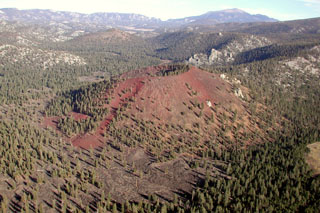 Groundhog cinder cone is the youngest of the Golden Trout volcanic field. It is seen here from the west with South Fork cone behind it at the upper left and Olancha Peak on the crest of the Sierra Nevada on the right horizon. Groundhog cone is breached to the NE and was the source of large lava flows (visible in the foreground) that traveled 6 km to the west. The flows filled the valley of Golden Trout Creek and displaced it to the north side, separating Golden Trout Creek from Volcano Creek at the southern margin of the flow.
Groundhog cinder cone is the youngest of the Golden Trout volcanic field. It is seen here from the west with South Fork cone behind it at the upper left and Olancha Peak on the crest of the Sierra Nevada on the right horizon. Groundhog cone is breached to the NE and was the source of large lava flows (visible in the foreground) that traveled 6 km to the west. The flows filled the valley of Golden Trout Creek and displaced it to the north side, separating Golden Trout Creek from Volcano Creek at the southern margin of the flow. 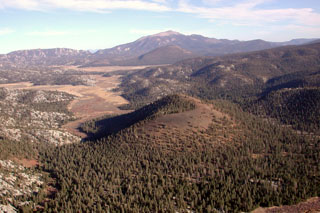 South Fork cinder cone (center) is seen from the NW with Ramshaw Meadow (upper left) behind it. Templeton Mountain is the rounded peak beyond South Fork cone, and Olancha Peak on the crest of the Sierra Nevada is on the center horizon. South Fork (Red Hill) cone was formed about 176,000 years ago and produced a lava flow 10 km to the west that may have reached as far as the Kern River. The cinder cone was erupted through a bedrock ridge of the Sierra Nevada, and inclusions of quartz monzonite are common near the vents.
South Fork cinder cone (center) is seen from the NW with Ramshaw Meadow (upper left) behind it. Templeton Mountain is the rounded peak beyond South Fork cone, and Olancha Peak on the crest of the Sierra Nevada is on the center horizon. South Fork (Red Hill) cone was formed about 176,000 years ago and produced a lava flow 10 km to the west that may have reached as far as the Kern River. The cinder cone was erupted through a bedrock ridge of the Sierra Nevada, and inclusions of quartz monzonite are common near the vents.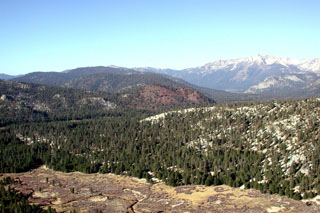 Groundhog cinder cone (center) is seen from the NE with Tunnel Meadow in the foreground. Peaks of the Great Western Divide across Kern Canyon in Sequoia National Park are visible on the right horizon. Groundhog cone is the youngest of the group of cinder cones forming the Golden Trout Creek volcanic field in the Golden Trout Wilderness Area. This nomenclature derives from the renowned Golden trout, which is a sub-species of rainbow trout and has been designated as the official state fish of California.
Groundhog cinder cone (center) is seen from the NE with Tunnel Meadow in the foreground. Peaks of the Great Western Divide across Kern Canyon in Sequoia National Park are visible on the right horizon. Groundhog cone is the youngest of the group of cinder cones forming the Golden Trout Creek volcanic field in the Golden Trout Wilderness Area. This nomenclature derives from the renowned Golden trout, which is a sub-species of rainbow trout and has been designated as the official state fish of California. There are no samples for Golden Trout Creek in the Smithsonian's NMNH Department of Mineral Sciences Rock and Ore collection.
| Copernicus Browser | The Copernicus Browser replaced the Sentinel Hub Playground browser in 2023, to provide access to Earth observation archives from the Copernicus Data Space Ecosystem, the main distribution platform for data from the EU Copernicus missions. |
|
WOVOdat
Single Volcano View Temporal Evolution of Unrest Side by Side Volcanoes |
WOVOdat is a database of volcanic unrest; instrumentally and visually recorded changes in seismicity, ground deformation, gas emission, and other parameters from their normal baselines. It is sponsored by the World Organization of Volcano Observatories (WOVO) and presently hosted at the Earth Observatory of Singapore.
GVMID Data on Volcano Monitoring Infrastructure The Global Volcano Monitoring Infrastructure Database GVMID, is aimed at documenting and improving capabilities of volcano monitoring from the ground and space. GVMID should provide a snapshot and baseline view of the techniques and instrumentation that are in place at various volcanoes, which can be use by volcano observatories as reference to setup new monitoring system or improving networks at a specific volcano. These data will allow identification of what monitoring gaps exist, which can be then targeted by remote sensing infrastructure and future instrument deployments. |
| IRIS seismic stations/networks | Incorporated Research Institutions for Seismology (IRIS) Data Services map showing the location of seismic stations from all available networks (permanent or temporary) within a radius of 0.18° (about 20 km at mid-latitudes) from the given location of Golden Trout Creek. Users can customize a variety of filters and options in the left panel. Note that if there are no stations are known the map will default to show the entire world with a "No data matched request" error notice. |
| UNAVCO GPS/GNSS stations | Geodetic Data Services map from UNAVCO showing the location of GPS/GNSS stations from all available networks (permanent or temporary) within a radius of 20 km from the given location of Golden Trout Creek. Users can customize the data search based on station or network names, location, and time window. Requires Adobe Flash Player. |
| Large Eruptions of Golden Trout Creek | Information about large Quaternary eruptions (VEI >= 4) is cataloged in the Large Magnitude Explosive Volcanic Eruptions (LaMEVE) database of the Volcano Global Risk Identification and Analysis Project (VOGRIPA). |
| EarthChem | EarthChem develops and maintains databases, software, and services that support the preservation, discovery, access and analysis of geochemical data, and facilitate their integration with the broad array of other available earth science parameters. EarthChem is operated by a joint team of disciplinary scientists, data scientists, data managers and information technology developers who are part of the NSF-funded data facility Integrated Earth Data Applications (IEDA). IEDA is a collaborative effort of EarthChem and the Marine Geoscience Data System (MGDS). |